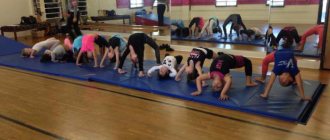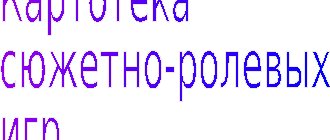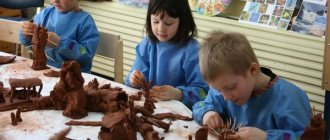Role-playing game "Barbershop"
Summary of a lesson on teaching role-playing games for children of senior preschool age with mental retardation
The play activity of preschoolers with mental retardation differs from the play of normally developing peers, first of all, by monotony, lack of creativity, weakness of imagination, insufficient coordination of play actions, and non-compliance with game rules. Meanwhile, a child who has not fully mastered the game will not be able to move on to the next leading activity – learning. In this regard, the problem of developing games (especially creative ones, including role-playing games) for the development of children with mental retardation and the successful correction of disorders becomes especially urgent. To reduce factors that negatively affect the development of gaming skills by preschoolers with disabilities and improve socialization, we conduct classes to teach children to play. This lesson uses techniques that help children master creative play and develop compensatory functions. This is, for example, creating a gaming environment before the game starts; viewing the presentation, looking at the illustrations with an emphasis on significant points; exercises in game actions; selection of paraphernalia together with children, making it with your own hands; verbalization of one's own actions.
To prepare for such classes, we conduct a variety of virtual excursions, transformation games, improvisation games, game situations, immersing children in various emotional states, organize didactic games, experimentation, modeling, productive activities; With their parents, our students visit social and industrial facilities (in this case, a hairdresser).
Tasks:
- expand children’s life experience, teach them to apply it in play activities;
- learn to formulate a game plan and implement it according to the intended algorithm;
- form speech mediation of activity;
- develop the ability to interact with peers in the process of unfolding the game plot.
Equipment
: presentation “The work of a hairdresser”, cards for the game “What is extra”; background and ready-made forms for applique, oilcloth, glue stick; dolls with long hair, a themed set “Barbershop”, a mirror, high chairs; catalogs with hairstyles, elastic bands, hairpins, aprons, badges.
Progress of activities
Teacher
: Guys, do you know a master who is good with scissors, a comb, a hairdryer, and can help people prepare for the holiday and make them more beautiful?
What kind of master do you think this is? ( Children's answers.
) Do you want to play hairdresser yourself?
( Children's answers.
)
Teacher
: To adjust your attention, we will do a warm-up with you: “Show me what I say, not what I show.”
( The teacher names parts of the body and touches them (forehead, stomach, knee, elbow, etc.). At some point, the teacher names one thing and touches another. For example, touches the back, says the stomach. Children must show what the teacher called.
) Guys, how can you call in one word what we showed you?
( Body parts
.) Well done to those guys who were attentive and didn’t make a mistake.
Teacher
: (
Showing the presentation “The work of a hairdresser.”
) Guys, what is shown here?
( Hairdresser
.) Let's learn about the professions of people working in a hairdresser.
Teacher
: (
There is a picture of “Administrator” on the slide
.) What kind of work do you think an administrator does?
( Schedules clients for haircuts and hair coloring at a time convenient for them.
) What items does the receptionist use?
( Phone, pen, magazine
.) What should it be like?
( Polite
.) Guys, who do we call clients?
( Children's answers
.)
Teacher
: (
On the slide is a picture of “Cashier
.”) What does a cashier do?
( Accepts payment for the service performed, gives change, knocks out a check.
) What tools does he use?
( Cashier, terminal, calculator, pen
.) What should a cashier be like?
( Children's answers
.)
Teacher
: (
On the slide there is a picture “Hairdresser”
.) Guys, who can be called a hairdresser?
( A master who works on creating hairstyles.
) What does a hairdresser need to work?
How should a hairdresser communicate with clients? ( Be polite, attentive, careful, patient
.)
Teacher
: (
On the slide there is a picture “Cleaning lady.”
) What does a cleaning lady do?
( Sweeps, mops floors, changes used towels
.)
Teacher
: (
On the slide is a picture “Manicurist.”
) What does a manicurist do?
( Does a manicure, cuts and paints nails.
) What tools does a master need?
( Nail scissors, files, tongs, varnish
.)
Teacher
: Guys, what rules of behavior exist between clients and hairdressing salon employees?
( They must be mutually polite.
)
Teacher
: And now we’ll play the game “What’s extra.”
Let's remember the rules. It is necessary to select an image of an extra object on each game card. ( The game cards show tools (scissors, comb, hair clips, pliers ), electrical appliances (hair dryer, mixer, terminal, hair curling iron), furniture (wardrobe, bedside table with mirror, bookcase, swivel chair). After each When choosing children, the teacher asks questions: Why is the subject superfluous? How can you call them in one word?
)
Teacher
: Guys, let's continue our activity in the creative workshop.
( We invite children to make hairstyles for the dolls for the holiday. Ready-made forms are laid out on the table. Children have the opportunity to choose a hairstyle and an image of the doll. Children comment on their actions. For example: “This girl’s name is Dasha. I want to make her braids with red bows. I’ll take braids, I’ll turn it over and put it on oilcloth, spread it with glue, glue it, smooth it out.”
)
Teacher
: Guys, imagine that we are going with you to a holiday.
What do you think is needed for this? ( The teacher leads the children to the idea that they need to look smart, and suggests that they go to the hairdresser to do this. The distribution of roles is carried out using a random selection technique: images of hairdresser workers are printed on cards. The cards are turned upside down with the image. Children take a card and perform the corresponding role
.)
Teacher
: After such a hard day at work, you need to rest a little.
Let's do a relaxing exercise called "Washing Your Hands." You need to rub your tense palms together, then “shake off the water” from your relaxed hands, using gentle movements to “wipe your hands” with an imaginary towel. ( Repeat several times
.)
Marina Svyatkina, Marina Savelyeva, teachers,
Alsou Antonova, teacher-defectologist, Oksana Kuznetsova, teacher-speech therapist, MBDOU No. 101, Ulyanovsk
Didactic game “Cheerful Hairdresser” for children of the second junior group
Valentina Melnikova
Didactic game “Cheerful Hairdresser” for children of the second junior group
Today I want to share a d/game that I once saw on the Internet. And I immediately wanted to make it for my kids. We called her “ The Cheerful Hairdresser ”. the game , although the “hair” has to be glued after each haircut. But the pleasure it brings is worth it. The game was made as part of preliminary work for the role-playing game " Barbershop ". With the help of this game, we introduce children to the profession of a hairdresser , enrich children's knowledge about the work of a hairdresser children's play plans , create a desire to independently organize a role-playing game, and expand the social experience of children . We also develop the ability to use scissors correctly and safely. a game cannot do without artistic expression. On the website “Poems. Ru" I found a wonderful poem " Hairdresser ", author Masha Prokhorova .
Activities with Children
Target.
Revealing the meaning of a hairdresser's activity. Formation of the ability to creatively develop the plot of the game. Fostering respect for the hairdressing profession.
Game material.
Homemade products, substitute items (various parts from a building kit in a conditional role: a block as a comb, cylinders as bottles, a flat plate leaning against a prism instead of a mirror, a prism as a machine, a narrow block instead of a razor), some real objects ( sheet, mirror, brush, bottles, comb), a set of special toys “Children's hairdresser”.
Preparing for the game.
Excursion to the hairdresser. Conversation with hairdressing salon employees. Making the album “Hairstyle Models”. Review of illustrative material on the topic. Making attributes for the game.
Game roles.
Hairdresser (master), clients, cashier, cleaning lady.
Progress of the game.
The teacher can begin preliminary work on the development of role-playing games with an excursion to the hairdresser. In advance, he needs to agree with the parents and obtain permission from two or three of them to cut their children’s hair. Then the teacher draws the children’s attention to the fact that Seryozha, Anya, Olya are neatly, beautifully cut and combed, they should be told that Lera and Sasha have long hair, it sticks out ugly, sloppy, so they need to go to the hairdresser and get a haircut. After this, the teacher tells the children that now they will go to the hairdresser, there Lera and Sasha will cut their hair, and everyone will roar and watch how the hairdresser will do it.
Approaching the hairdresser, the teacher should draw the children’s attention to the sign. In the hairdressing salon, you need to show the children the tools that the masters use, introduce the children to their names, purpose, and method of operating with them. So that children can watch the hairdresser at work, the teacher asks several children to cut their hair, who thus come into contact with the hairdresser and participate in his activities as clients. At the same time, the teacher should draw the children’s attention to the relationships between the foreman, cashier, clients, and cleaning lady.
The children watch how their comrades get their hair cut, how they thank the master, how they themselves pay into the cash register, give the check to the master, etc. Along the way, the teacher explains to the children everything that they see; emphasizes the politeness of the master, his desire to serve the client as best as possible, to make him beautiful and neat; draws children's attention to his relationships with other employees of the hairdressing salon.
In the group, the teacher systematizes the acquired knowledge and impressions through conversation and showing illustrative material depicting a hairdresser and the work of a hairdresser. At the same time, the teacher must pose questions to the children so that, when answering them, they can draw on their own experience acquired during the excursion.
Also, the teacher, together with children and parents, can make an album “Hairstyle Models” using children’s drawings, clippings from magazines, etc.
After this, the teacher, together with the children, can make the items necessary for playing “hairdresser”: cut out of cardboard along the drawn contours a comb, razor, brush, machine, scissors, bottles, spray bottle, mirror. The mirror can be covered with cellophane paper on one side, and a stand can be glued to it on the other side. Glue a ribbon to the spray bottle as a rubber tube, and glue its other end to the bottle, which shows the level of the cologne in it. The teacher makes the scissors, clipper and razor. Each of these items consists of two parts, held together by thread, making these parts movable. The lower part of the bottles is bent at a right angle for stability. When the crafts are ready, the teacher must play with them and show the children how to use each one in a game. In the process of making and playing with crafts, the children learn their names.
When teaching children this game, it is advisable to adhere to the following sequence when introducing game items: 1) homemade products; 2) substitute items (various parts from a building set in a conditional role: a block - as a comb, cylinders - as bottles, a flat plate leaning against a prism - instead of a mirror, a prism - as a machine, a narrow block - instead of a razor) ; 3) some real objects (sheet, mirror, brush, bottles, comb); 4) a set of special toys “Children’s hairdresser”.
First, it is most advisable to introduce homemade items into the game: firstly, when making these crafts, the children also became acquainted with the method of using them; secondly, if children learn to play using homemade objects, it will no longer be difficult for them to start playing with ready-made toys. Thirdly, bright and entertaining ready-made toys will be happily accepted by children after homemade and conventional ones, while homemade items introduced after ready-made toys will not arouse interest and will not stimulate children to update their play. Fourthly, ready-made toys, introduced at the beginning of teaching a game topic, can distract children from the meaning of the game actions being performed.
The teacher does not need to abuse the simultaneous introduction of a large number of real objects into the game. Some of them, for example, a clean sheet (which is used to cover the client during a haircut), the teacher can give whenever the children play “hairdresser”; others, for example, a mirror, a brush, a comb, can be given selectively.
When the game is first played, the teacher takes on the role of the hairdresser. He directs the course of the game with his actions, questions, and remarks.
If the child does not know how to behave during the game, the teacher asks him: “Should I cut my hair?”, “With scissors or a clipper?”, “Should I spray with cologne?” etc. After this, asks the client to bend his head, close his eyes, etc.
The very next day, the teacher can entrust the role of hairdresser to one of the children, and the teacher, having become a client, again leads the game.
Over time, the game should be modified by replacing the game objects with which children operate. Then we need to help children develop and enrich the concept and plot of the game. Thus, a haircut in a hairdresser may serve a specific purpose, for example, children cut their hair to go to the circus, for a holiday or to visit, etc.
MAGAZINE Preschooler.RF
Summary of a role-playing game for the senior group “Beauty Salon”- Babynina Tatyana Nikolaevna
- Moroz Ekaterina Alexandrovna
- Kovalenko Marina Viktorovna
Teachers of the MDOU "Combined kindergarten No. 19, Razumnoye village, Belgorod district, Belgorod region"
Project participants: teacher and senior children.
Goal: to develop in children the ability to play the role-playing game “Beauty Salon” .
Tasks
Educational: learn to combine knowledge obtained from different sources, reflect it in a single plot of the game; encourage children to independently assign roles and prepare the necessary conditions;
Developmental: develop the ability to coordinate game storylines and role-playing actions, agree on a sequence of joint actions.
Educational: to cultivate a culture of behavior in public places, respect, polite treatment of elders and each other, teach gratitude for the help and service provided.
Roles: administrator, manicurist, hairdresser, makeup artist, clients, cleaner.
Equipment: building material, mirror, combs, shampoo bottles, curlers (caps from old felt-tip pens), game set for a hairdresser; wallet, money (papers, mosaic pieces, lotto chips), phone (brick), bag (for the client); pen, cash register, money, fashion magazines (for the administrator); files (sticks), cotton swabs and disks, bath, jars and bottles (skittles); robe, scarf, gloves, bucket, basin, mop (stick); game set for makeup artist.
Preliminary stage.
Conversation with children: “What do they do in a beauty salon?”
Questions:
— what kind of halls are there?
— what types of work are carried out there? (haircut, hair wash, manicure, makeup, hair dyeing, hair styling, etc.)
- How should you behave in a beauty salon?
Reading fiction: S. Mikhalkov “In the Barber Shop” , M. Skrebtsova “The Wonderful Hairdresser” , E. Uspensky “A Scary Story” .
Excursion to a beauty salon. Observing the work of craftsmen. Looking at fashion magazines and catalogues.
Educational games:
Word games with objects: “What the masters can do” ; “Who needs what for work?” ; “I know 5 items that I use...” (administrator, hairdresser, makeup artist, manicurist)
Imitation games: “Guess by actions” ; “We won’t say what we saw, but we will show what we did . Games - dialogues: “Talking on the phone” ,
Creation of the workshop “Young Beauty Salon Designer” : signs “Beauty Salon” , signs for the names of the rooms; making friezes “Fashionable hairstyles” , “My fashionable image” , “Beautiful marigolds” .
Selection of materials for the game, preparation of scenery and attributes.
Progress of the game.
There are stands on the carpet with a red ribbon tied between them.
— Guys, the Defender of the Fatherland Day holiday is coming soon! . This is the holiday of your dads, grandfathers and our boys - future soldiers. Girls, do you want our boys to enjoy this holiday? Where can I get my hair cut, my hair done, my nails done, my makeup applied?
- In a beauty salon.
— Today the “Beauty Salon” opens.
-And the right to cut the ribbon will be given to the one who gives the most definitions for the word soldier and warrior (what is he?), I give incentive tokens for the correct answer. Whoever has the most tokens will cut the ribbon.
Distribution of roles.
- Children, remember we talked to you about who works in the beauty salon?
Who will work in our beauty salon? Who will do the hair and makeup for our fashionistas on our boys' day?
Intended roles:
- Hairdresser (does hair, washes hair, cuts hair).
- Manicurist (does manicure).
- Administrator (the teacher takes on this role).
- Cleaning lady (cleans the room, changes towels).
- Makeup artist (does makeup).
- Clients.
— While our girls are visiting the beauty salon, our boys will be constructing a “Dance Floor” from large building material (the boys go off to make a round area for half the group for the ball)
Playing out storylines.
- Children wear special clothes. They take their jobs.
- All clients wait on chairs for their turn.
- The first client comes in. Approaches the administrator. He asks if he can get a manicure.
- The administrator takes the client to the master.
- Manicurist. Processes tools, files nails, paints, writes out a receipt.
- The client thanks the technician and goes to pay the receipt to the administrator.
- The administrator knocks out a check and offers to visit the salon again.
- The second client goes to the hairdresser. The hairdresser clarifies. What kind of haircut or styling will be done? He does his hair and writes out a receipt.
- The cleaning lady sweeps the floor and changes the towels.
- The administrator reports that a new vacancy has appeared for “makeup artist” .
- Another storyline arises, the role of a makeup artist is added.
- He calls, the administrator picks up the phone, and they ask him if he can come to an appointment with a makeup artist. The administrator replies that a makeup artist’s office has opened and that you can come, they will be glad to see him.
- Makeup artist waiting for a client, preparing his workplace.
- A client arrives, the administrator greets him and escorts him to the master.
- The master does makeup, paints eyes, eyelashes, applies powder. Issues a receipt.
- The client thanks the master, goes to pay the receipt to the administrator and makes an appointment to have his hair done by the hairdresser.
The game continues until all the girls (clients) visit the beauty salon.
- New story: girls, after the beauty salon, go to a party with the boys.
The final stage
- Capturing children in photographs;
- Discussion of the game;
- Collection of equipment and attributes.
| Next > |




